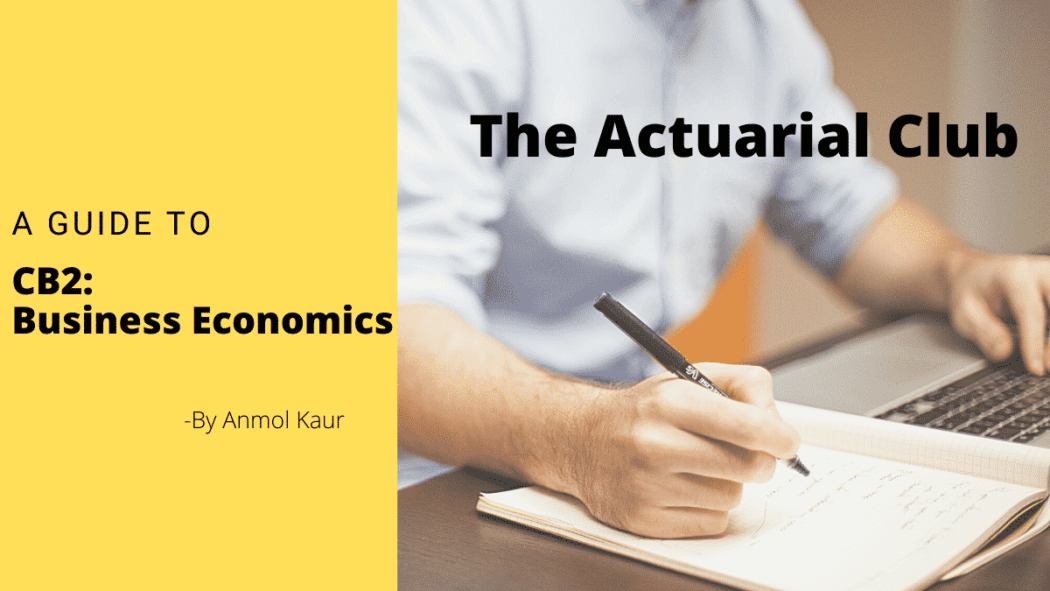The older subject CT7 (Business Economics) has been transferred to CB2 (Business Economics) subject under the new curriculum of IFoA and IAI (after 2019).
It is an exam that gives you an idea of how the world of economics works. It teaches us how economic concepts can be applied to the businesses to facilitate decision making.
This exam explores the fundamentals of Microeconomics and Macroeconomics.
CB2 is a three-hour and fifteen minute assessment divided into three sections as follows:
- Economic models and their historical applications (10% weightage)
- Microeconomics – the study of behavior of consumers, firms, and markets (45% weightage)
- Macroeconomics – the study of relationships between governments, markets and firms, government policies and international trade (45%weightage)
The exam consists of 26-30 multiple choice questions of 1.5 marks each and around 6-10 long and medium answer questions of around 5-12 marks.
IFoA recommends studying for 150 hours for this exam.
No, It isn’t necessary to take coaching for exam as it is considered one the easiest exams of the Actuarial curriculum. For those who have studied Economics as a part of their High School subjects or as a part of their University’s curriculum, this exam will be very easy to prepare for.
For those who haven’t studied Economics earlier will also be able to understand it properly by studying Core Reading provided by IFoA as it explains in a very detailed, easy manner, all the concepts along with their examples.
Yes, CB2 is an application-based theory paper which comprises of MCQs, graphs also.
Some new topics are added to CB2 syllabus such as Macroeconomic history, the role of financial markets, participants in financial markets, economic thinking strands, indifference curves, and budget lines. Chapter 4, chapter 10 and some portion of chapter 9 are removed and there are some additions to chapter 17.
We recommend you to study from the new CB2 curriculum Core reading and also study the specified pages of John Sloman Economics Book that are advised to be read in the Core Reading material.
The topics covered under CB2 curriculum are:
1. Basic economics concepts like scarcity, choices made by businesses.
2. The difference between Microeconomics and Macroeconomics.
3. The economic thinking strands of various models of economists.
4. Recent history of macroeconomics.
5. Concepts of Market Demand and Market Supply.
6. Equilibrium Concepts.
7. Price and Income elasticity of Demand and Supply.
8. Costs, Revenue and Production Functions for businesses.
9. Consumption Behavior.
10. The effect of Advertising on businesses.
11. Different types of markets- ,Monopoly, Monopolistic and Oligopoly.
12. Various Pricing strategies/
13. Globalization.
14. International Trade.
15. Balance of Payments.
16. Exchange Rates.
17. Role of Money and interest in the economy.
18. Inflation and various ways to control it.
19. Unemployment and its effects on Economies
The IFoA declares pass marks of each subject at the result declaration. For CB2, it remains close to 60 marks for the 100-mark paper.
1. Self study the Core reading material with great focus.
2. Practice Graphs, numericals related to elasticity and Costs.
3. Practice time management.
4. MCQs are bit confusing. So, practice them from past year papers as much as possible.
5. Before the exam, practice atleast 5 past year papers effectively. This will give you an idea of how write to the point explanation to questions.
The exam fee structure of IFoA can be found here.
All the best for your exam!
Let us know in case you have any questions about the exam in the comments section!
Read more about other Actuarial Exams at The Actuarial Club here :
► CM-1 >> About the Exam , Chapter’s Summary
►CB-1 >> Tips and Tricks
►CS-1 >> Guide to exam

